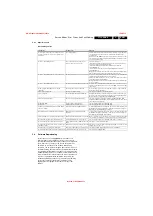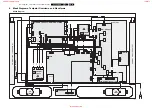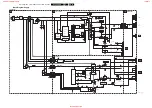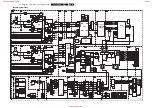
Service Modes, Error Codes, And Fault Finding
5.
5.8.3
Repair Tip Table
Table 5-4 Repair tips
5.9
Software Downloading
In this chassis, you can
upgrade
the main software via
ComPair without removing the back cover of the TV (it is
possible that early production sets don’t have a hole in the back
plate, in this case you have to remove the back plate). The
switch, which is needed for the software downloading
procedure, can be reached through a gap in the back cover or
the SSB shielding. The switch can be operated with a toothpick
or something like that. Make sure that you do not damage the
PWB with sharp objects. You can find more information on how
this procedure works in the ComPair file. It is possible that not
all sets are equipped with the hardware, needed to make
software upgrading possible. To speed up the programming
process the firmware of the ComPair interface can be
upgraded. See paragraph “How To Order” for the order
number.
Phenomenon
Possible Cause
Repair tip
“F” in the right corner of the screen and the set is not
reacting on the remote control. The local keyboard is
functioning.
TV is in factory mode.
Press the “VOL-” button on the local keyboard for at least 3 seconds. Switch the
TV “off” and back “on”. The TV has now left Factory Mode and functions
normally again.
When pressing the “MENU” button on the local keyboard for at least 3 seconds,
you only leave Factory Mode temporarily. After switching “off” and back “on”, the
TV is in Factory Mode again.
No picture, LED blinking at 3 Hz.
Set is in protection due to various causes.
For error codes see error-code list.
You have no picture, so:
- Read the error buffer via ComPair (error buffer is accessible when set is in
protection, ComPair-file will guide you to this).
- Read the blinking LED information via standard remote command
<mute>
06250x
<ok>.
- Or you read the error code sequence via standard remote command
<mute>
062500
<ok>.
When you have found the error, check the circuitry related to the supply voltage
and I
2
C-communication or the circuitry that triggers the protection.
No picture, LED blinking with code 6-6-6 or 18-18-18.
No communication on slow I
2
C- or fast I
2
C-bus. As processor cannot communicate with one of the 2 buses, the Stand-by-LED
spontaneously starts blinking 6-6-6-etc. or 18-18-18-etc...
If in the error buffer somewhere is an error 6 or 18, these will have the highest
priority starting the mentioned blinking.
Measure, dependent of the error on the I
2
C-bus, which device is loading the bus
(use I
2
C-overview).
No picture, LED blinking with code 1-1-1.
No communication on NVM-I
2
C bus to the uP.
As the uP cannot communicate with the NVM I
2
C bus, it spontaneously starts
blinking 1-1-1.
Note:
when there is no access to the NVM, a lot of picture setting
can go wrong.
No RC-reception. Blue LED does not echo RC-
commands.
uP circuitry or RC-receiver is defective.
In case the TV does react on a local keyboard operation, you must check the
RC-receiver circuitry (diagram “J”).
Picture is not synchronised.
The sync is derived in the HIP.
Check crystals in the HIP circuit on bad contacts.
Picture is distorted.
Check video-path in Service Default Mode.
Investigate whether there is an error code present in the error buffer. In case
there is one, check the I
2
C-bus and/or supply lines (see overview supply lines).
Measure and check signal path Tuner-HIP-FBX-EPLD.
Picture with horizontal stripes.
Pixel Plus processing is malfunctioning
Check functionality on circuitry (B3a, B3b, B3c and B3d) of PICNIC, FEM,
EAGLE, COLUMBUS and/or field memories.
Tip:
the whole Pixel Plus chipset
can be diagnosed via ComPair.
No NextView (EPG).
IC7012 defective or not powered.
Check circuitry around IC7012 on diagram “B5a”.
No Teletext.
IC7007 defective or not powered.
Check circuitry around IC7007 on diagram “B5a”.
Problems caused by EPG (Electronic Program Guide).
The TV set "hangs".
Problems with NexTView EPG broadcasts.
To switch from EPG 2C3 to Teletext guide, press for 4 seconds, simultaneously
the MENU button on the TV and digit 0 on the remote. The option settings for
NexTView type and FlashRAM will not change.
NexTView EPG is not functioning only Teletext guide.
EPG version 2C3 is switched “off” during
production.
To switch from Teletext guide to EPG 2C3, press for 4 seconds, simultaneously
the MENU button on the TV and digit 1 on the remote. The option settings for
NexTView type and Flashram will not change.
Various symptoms, due to missing local supply voltage.
An interrupted fuse, NFR-resistor or connection. When no symptom or error code leads you to a specific circuitry, use the supply
lines overview (see supply lines overview), for a quick scan of all supply lines.
No sound at the speakers but sound at monitor out.
Possible problem with the class D amplifier
Check circuitry around IC7700 on diagram “SA3” (LCD) or “C” (PDP).
No sound at the speakers but sound at monitor out.
Sound enable from OTC is HIGH, speakers are
muted
Check pin 95 of OTC on diagram “B5a”.
No sound at the speakers not at monitor out, but sound
at SCART 1 output.
POR line is low, anti plop circuit mutes the sound Check pin 8 on connector 1739 on audio panel. Diagram “C” for PDP sets and
diagram “SA3” for LCD sets
No sound from any output (except headphone)
Reset audio is high or MSP is not properly reset Check pin 16 of MSP (diagram “B6a”) and circuitry around MSP.
No sound from the tuner but sound from any other input. Problem with the delay line (PDP sets only)
Check circuitry on diagram “B6d”.
www.freeservicemanuals.info
17/6/2013
World of free manuals




































